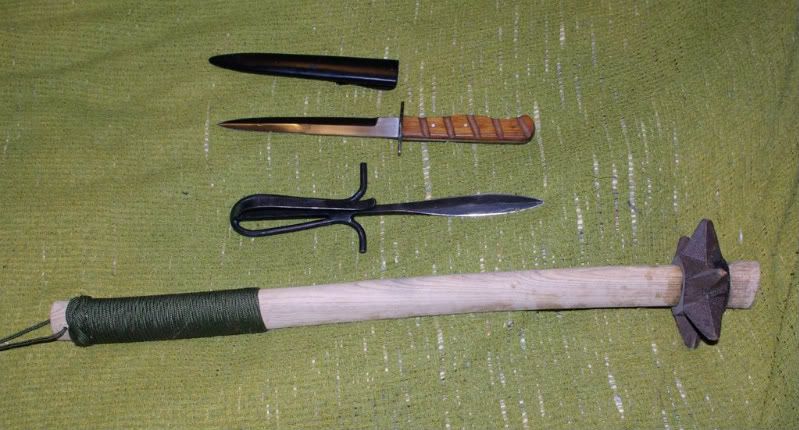
 |
|
|
#1 |
|
(deceased)
Join Date: Feb 2005
Location: Centerville, Kansas
Posts: 2,196
|
Picked this up recently and really have no idea of what it is. Looks like it could be a dagger, a spear tip or some kind of tool. Possibly a reworked bayonet / trench art? It has the #906 stamped into the round portion of the blade and a heavy hollow copper grip or ferrel. Any and all help in identifying what it is and where it might be from will be greatly appreciated. Thank you. Robert
Total length 13-1/2" Blade length including round section 9-5/8" Blade at widest 13/16" Blade at thickest 1/4" Grip Length 3-7/8" |
|
|

|
|
|
#2 |
|
Member
Join Date: Mar 2007
Posts: 407
|
Could the grip be a reworked shell casing?
Josh |
|
|

|
|
|
#3 |
|
Member
Join Date: Jun 2008
Location: The Sharp end
Posts: 2,928
|
What are the markings, just 906? Its like a crude sleeve bayonet, but the blade is very well made. I wonder if it is a 'trench art' functional bayonet?
|
|
|

|
|
|
#4 |
|
Member
Join Date: Jan 2006
Location: Kent
Posts: 2,658
|
Interesting...
I have seen a number of WW1 reworked bayonets fitted with a cartridge case hilt. After the return of the soldiers, food was a priority and 'every day' tools were more scarce (a lot of steel/iron was taken and used to manufacture guns, tanks etc). Many started to 'grow their own' food ...a number of these bayonets were mounted onto short shafts (hence the percussion cap removal from the shell so that it could accomodate a 'stick') and used as gardening implements etc. That could be the case here  .....reminds me of that expression about swords and ploughs ..and 'necessity is the mother of invention' A great 'snap shot' of history. Regards David |
|
|

|
|
|
#5 |
|
(deceased)
Join Date: Feb 2005
Location: Centerville, Kansas
Posts: 2,196
|
Thank you all for your interest and comments on this item. The copper sleeve seems much to heavy and thick walled to have been a shell casing, at least for any that I have seen. The only markings on this is just the # 906. The blade is very well made but not real sharp and I'm not sure it ever was. Again my thanks.
Robert |
|
|

|
|
|
#6 |
|
Member
Join Date: Jun 2008
Location: The Sharp end
Posts: 2,928
|
Is the 906 rubbed? could it have been 1906?
|
|
|

|
|
|
#7 |
|
(deceased)
Join Date: Feb 2005
Location: Centerville, Kansas
Posts: 2,196
|
Hi Atlantia, It is possible that there could be a 1 under the copper sleeve but I would have to remove it to find out and I really don't want to risk damaging anything.
Robert |
|
|

|
|
|
#8 | |
|
Member
Join Date: Jun 2008
Location: The Sharp end
Posts: 2,928
|
Quote:
|
|
|
|

|
|
|
#9 |
|
(deceased)
Join Date: Feb 2005
Location: Centerville, Kansas
Posts: 2,196
|
Looking down the tube all that can be seen is green copper oxidation, the rusted flat end of the round portion of the blade end and what appears to be the remnants of some kind of rosin or pitch.
Robert |
|
|

|
|
|
#10 |
|
Member
Join Date: Mar 2006
Location: Room 101, Glos. UK
Posts: 4,263
|
during WW1 the combatants found that a knife was more handy in the trenches than a sword or issue bayonet (the ones in use were usually long sword bayonets) so the trench knife became a field expedient.
they were produced from cut down bayonets, barbed wire posts, large nails, anything that could be turned into a weapon by the local unit armourer. the germans, of course were more organised and produced large numbers of trench knives. the brits, besides knives, were rather fond of coshes (wood handle with a lead lump on the end, frequently covered in leather) or trench maces of cast iron to fit the entrenching tool handle. the french made a large number from old lebel bayonets, and from large nails and barbed wire posts. quite a variety would have been made by local 'designers' and i'd guess that yours was one. unfortuneatley most of them never made it to the trenches, as the owners got machined gunned before getting there, but some were used to great effect.  top, german grabendolche, boot scabbard. middle, french nail knife. bottom UK trench mace. |
|
|

|
|
|
#11 |
|
Member
Join Date: Nov 2006
Location: The Netherlands
Posts: 2,238
|
The blade does not fit in the picture of any WW1 bayonet that I know.
And also the shape and finish of the brass handle does not make is a perfect close combat weapon. So I don't whink this is a fighting knife. maybe it is a reworked tent peg that could now be fitted on a wooden pole. But that is merely a guess 
|
|
|

|
 |
|
|